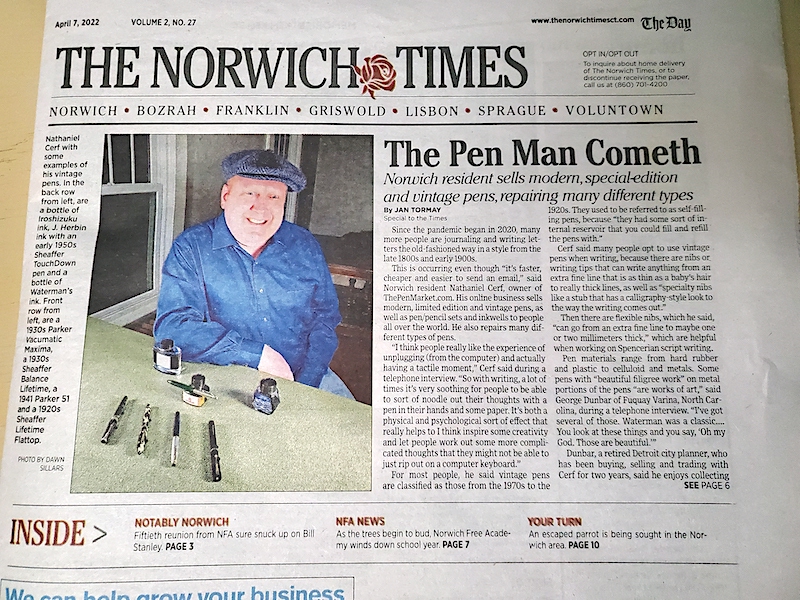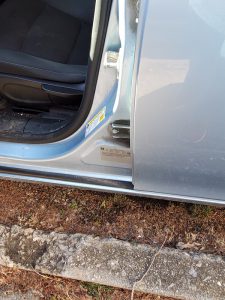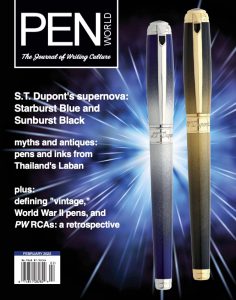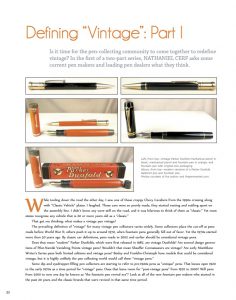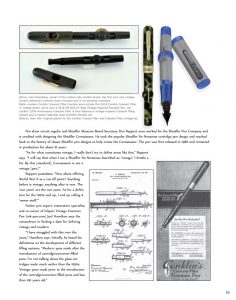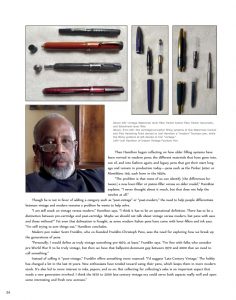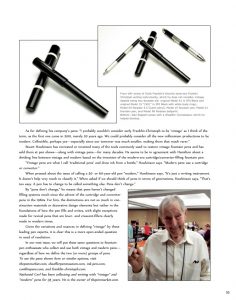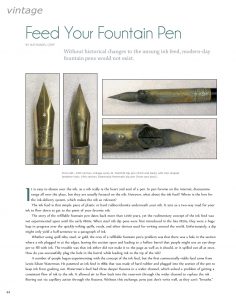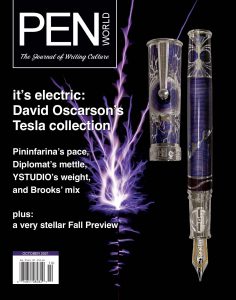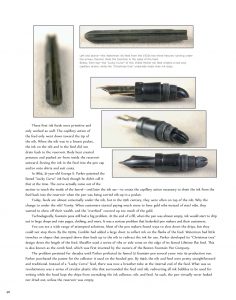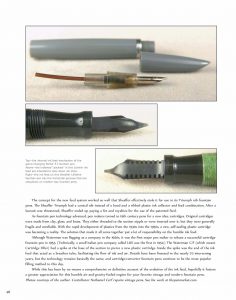News about ThePenMarket.com is spreading. I was lucky enough to be honored by a front-page feature in The Norwich Times! We’ve been featured before in “Pen World” magazine. However, I think this is our first time in a newspaper. Check it out: https://www.theday.com/local-news/20220406/norwich-resident-specializes-in-modern-vintage-pens

How Do I Buy a Used Car?
Spring is here, and, traditionally, this is a time many people start looking for a car. The Covid pandemic has limited the number of new cars on the market, and many people are turning to used cars to replace their set of wheels.
Buying a used car can be a stressful experience, especially now when used cars are selling at extremely high prices. As such, I thought I’d try to help you navigate these challenges.
I can already hear you. “Wait, Nathaniel. This is a pen blog. What do you know about used cars?”
As fate would have it, my first job out of college was as a salesman for a national chain of used car dealerships. Part of our training was to prove how our cars were better than other dealerships’ cars. And so, we were trained to spot damage in a used car and the possible ways other dealers might fleece people on financing. The following information has saved me and my friends a lot of money and heartache over the years. Hopefully, it will help you, too.
Knowledge is power, and it is best to power-up before you start shopping in earnest. If you know it is time to replace your old ride, start taking a closer look at the cars you see on your daily commute and in the parking lots you frequent to get an idea of what you like. Also keep in mind what you need the vehicle for. You might want a two-door Porsche, but if you have a family of five, you’re gonna need something bigger with trunk space. As we go into a new cycle of high gas prices, seriously consider what type of mileage this vehicle can get. As gas toys with $5-a-gallon, that bad-ass SUV you love that gets 12 miles per gallon might give way to a Toyota Prius that gets 40mpg. As you narrow in on a couple models that you like, research their common problems and pricing. Every car has a weak spot. For example: Subarus frequently have problems with their head gaskets. Chevy Cruze sedans are notorious for blowing out their original factory turbo-chargers. Check to see if these problems have been fixed in the car you ultimately buy. Most models of cars have a fan website where you can ask other owners about mechanical issues. Plus, Kelly Blue Book (kbb.com) has up-to-date pricing for every year, make and model of car at different mileage and trim levels. Don’t let old stereotypes hold you back. It used to be everyone thought American cars were untrustworthy and Japanese cars were built to last forever. Well, American quality control has gone up and Japanese quality control has seen a dip. It really is best to research the year, make, model and trim line you are interested in to make sure you are getting what you want.
Searching the internet makes it so much easier to locate a car you want. Google “used Honda Accords near (your zip code)” and you’ll likely get every Accord available in a 20 or 30-mile radius. This makes it easy to do some simple comparison shopping. Prices, mileage, colors, etc. Yet, there are many other variables to consider. A certified Ford F-150 from a Ford dealership might be a little more expensive, but it might also come with guarantees that “Crazy Bob’s Used Truck Emporium” might not have. Some dealerships guarantee that all of the maintenance is up to date and even give you a limited warranty to make sure all is as they promised. Others don’t. Get every dealer’s guarantee in writing before you take the plunge. Some smaller dealerships don’t offer any guarantees, but this does not automatically mean they are bad or untrustworthy. If you know what to look for, often you can save hundreds on a vehicle from a mom-and-pop dealership. BUUUUT, if the deal looks too good to be true, definitely take a closer look. Also check to see which dealers negotiate a price. Some certified places don’t negotiate and some do. Most smaller dealerships are all about negotiating.
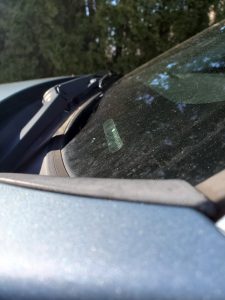
Vehicle Identification Number. Every car has one, and they are always located on the driverside front dash under the windshield.
Once you’ve narrowed your list down to two or three vehicles, it is time to go see them in person. Bring any and all the notes you want with you, and bring something to take notes with. Used car salesmen certainly have a stereotypical reputation, but not everyone is like that. As a former car salesman, I humbly request you be respectful and courteous until they give you a reason not to be.
A visual inspection of the vehicle is critical. One of the ways to make a ton of money on a used car is to take a wreck for scrap metal pricing and make it look close to new for $2,000 to $5,000. As many used cars these days are selling for $15,000 to $20,000, it is easy to see the incentive to do this. Unfortunately, the safety features and structural integrity of the car are ruined, and another crash could easily kill its occupants.
Take notes on all of the chips in the paint (road rash), especially on the front bumper, grill and hood. Look for door dings, etc. It is illegal in many states to sell a car with a cracked windshield, so keep an eye open for that, too. That’s the easy stuff, and although you might be able to save a little money on the cosmetic damage, it might also be a good indicator that the car has never been in a serious wreck.
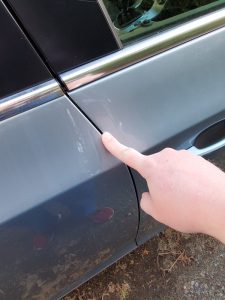
Run your finger over the seams between panels of your car’s exterior. Are they evenly spaced between panels? Is the paint smooth or bumpy?
Does the paint look uniform around the vehicle? In the right light (more often on a cloudy day), you can see where a couple doors on one side or the back bumper and trunk look a little lighter or darker than the rest of the car. If you can see three or more connected discolored panels, odds are good the car was in a serious wreck. Run your fingers along the seams between all of the exterior panels of the car. Does the seam get wide then narrow or vice versa? Seams from a factory-fresh car are uniform and don’t get narrow or wide at points. Non-uniform seams are an indicator that the panels have been removed and/or replaced and put back together. ALSO, as you run your finger over every seam, does the paint start to feel bumpy or lumpy. This is another great indicator that the panel was repainted. A factory paint job is universally smooth and perfect—no bumps or lumps.
Open all of the doors, hood and trunk at once. On every compartment of the vehicle there should be factory installed stickers with the V.I.N. (Vehicle Identification Number). Technically, a body shop should order and replace those stickers after a repair job, but virtually none of them do. If vehicle stickers are missing, then the odds are good that panel was replaced…an indicator of a car crash.
Regarding VIN numbers, many dealerships now give VIN reports to let you know if the car was ever listed as stolen, in an accident, in a flood or otherwise seriously damaged. Unfortunately, a clean VIN report does not guarantee the vehicle has never been in an accident. Although most states legally mandate body shops report serious damage on a VIN, many shops never report the damage to the state. You also can use the VIN to check the maintenance records. Say you are at Murphy van Mufflerson’s Used Car Lot and are looking at a Jeep. You can write down the Jeep’s VIN and then call a local Jeep dealer for the maintenance records. If Jeep/Chrysler serviced the vehicle, it will have all of the records of the service and recalls it performed on the vehicle anywhere in the country.
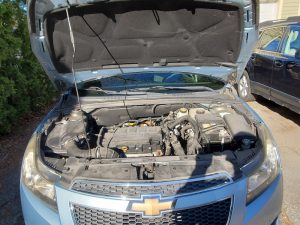
You can see the paint on all sides of the hood and along the panels matches. Plus, you can see the stickers are present and the welds are small and smooth. Plus, there are no leaks visible in the engine.
Also look to see if the paint on the outside of the panel matches the inside. If it doesn’t match, the panel was repainted at the very least. For example, a replacement hood might look like your car’s color on top but black or a different color underneath. A factory-original hood is painted the same color uniformly on top and bottom.
Another important thing to look for are the welds. Factory welds are very small, clean and precise. Sometimes a body shop will leave huge messy welds to fill holes or reattach badly mangled and straightened parts.
One last thing to look for are the bolts that hold the vehicle together. There is no reason the bolts should ever be undone for routine maintenance. If you can see where the bolt has stripped the paint from two panel pieces it is holding together and is maybe wearing through the metal, that is a clear sign of a problem and a likely indicator that those panels had to be removed to fix something from an accident. Even if a car is 40 or 50 years old, those bolts should be still be in place from when it was first built.
How are the tires? You should have enough tread that if you stick a penny head-first in the tread lines. Lincoln’s head should start to be covered by the remaining rubber of the tire. If his head is completely visible while in the tread, the tire is bald and needs to be replaced. Also look to see if one side of the tire is more worn on one side or in the middle. At the least, heavy wear on one side of a tire means the car is out of alignment. Yet, it could be an indicator that frame is bent or there is some other problem. Usually, the car just needs an alignment, but it is important to know for the future health and wellbeing of the vehicle.
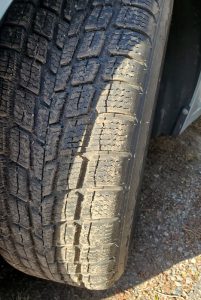
This is a new tire with deep tread, but you should always check to see if there is enough tread and even wear on the tire on your own car, as well as one you are looking to buy.
If you don’t mind getting dirty, get on the ground and look at the frame of the vehicle. If a frame was badly bent and then straightened, you will see big clamp or teeth marks in the frame rails near the tires. They won’t look natural to the construction of the vehicle. If you see these, stop what you are doing and do not buy the car. Every manufacturer designs a frame to have various tolerances for safety in a collision. If a frame is bent and then straightened, the metal fatigue in the frame guarantees the car will not be safe if you get in an accident. The metal fatigue also can create other problems in the wear and operation of the vehicle.
If you like what you see so far, it is time to take a closer look at the interior. Start with the trunk and pull up all of the carpeting in the trunk until you can see bare metal. Look for bad welds, but also look for mud, leaves and water damage. Smell for mold. It is illegal to sell a flood damaged vehicle in most states, but every hurricane season and flood season still finds flooded out cars heading to markets in other states. Most people who sell flood-damaged cars are good about cleaning all of the upholstery and engine compartment, but they frequently overlook the trunk compartment under the carpeting. If flood water gets into a vehicle’s engine, the engine will be shot within short order.
While you are in the trunk, check the spare tire, assuming this car still comes with a spare tire and jack, or for the tire repair kit.
Sit in all of the seats to see how the car feels for every passenger and play with all of the features in every seat position. It is better to find out before you buy the car that everything is working as it should. Sometimes things get overlooked at even the certified used car dealers and they’ll fix the problem before you buy the vehicle. Broken features also help you reduce the price for dealers that don’t fix the broken things.
Close up the vehicle, sit in the driver seat and make sure everything works. Even if it is a 100-degree day, turn on the heater to make sure it is working. Do the same in winter for the air conditioning. You can hear the condenser motor turn on, even if you can’t feel the difference between the cold air outside and inside. Check the radio and speakers, but don’t leave them on.
When you take a test drive, make sure the radio is off, so you can listen for any and all problems. Roll the windows up, at least for a little while, to just listen as you drive. You can even politely ask the salesperson with you to be quiet for a minute. Have any rattles or not-normal sounds checked out.
Even if a car sits unused for as little as a week, the brakes start rusting. This is okay. At the start of the drive, braking might sound pretty awful. Don’t worry about that. However, if the sound doesn’t go away in 5 or 10 minutes worth of driving, the car might need new brakes. It would be worth having them checked by a technician before buying the car.
As I am not a mechanic, I don’t know what to tell you to look for on the engine and transmission. When the hood was up, if you see an obvious leak, that is a bad sign. Otherwise, it is always wise to have your trusted mechanic give the car an inspection just to make sure all of the systems are in good shape. Most mechanics will offer this type of service for $50 to $100. Yet, a long-time family mechanic will often do this for free if he or she knows you well and knows you’ll be bringing them the car for maintenance over the years.
Are you ready to buy?
Your pricing research from earlier will help immensely. If you can point to a website with accurate pricing for exactly what you’re looking for, it is hard for the dealership to argue with that price. Use your notes about the cosmetic flaws or defects you want repaired to help you. There’s a little grey area depending on what extra features their car might have or their service might account for in terms of maintenance and warranty, but you should be able to hold them to a competitive price or walk away from the deal. When you start to walk away, count in your head how long it takes for the salesperson or their manager to come running after you. If your idea for a price is in the ballpark, they won’t let you get far.
Yet, even after you’ve agreed to a price, you aren’t free and clear, yet.
If you have a trade-in, be ready to negotiate that price as well. You can get the most out of your old car by selling it yourself, but most of us don’t want to deal with the hassle. Kelly Blue Book has a helpful tool to let you know the reasonable trade-in values for your old vehicle compared to the retail values.
If you have to finance the vehicle, it is important to know your credit rating going into the deal. Dealerships don’t just make money on the vehicle. They also make money on the financing. When the salesperson hands you off to the finance person, the finance guy gets paid bonuses by how high a percentage rate he (or she) thinks he can get out of you. Used cars have loan rates that are higher than new cars no matter who you go to. The best rates typically go to people who are in credit unions. Check your credit union or bank’s rates for a used car loan before you get a rate from the dealer. If you have good credit, and the bank thinks it can get you a 5.9% interest rate, take that information with you to the dealership.
Once you have the trade-in figured out, the finance person will put your info in the system and come back to you within seconds with a loan offer. Often they don’t share their screen with all of the loan offers with you. Usually they have a screen/computer in a separate back office they must consult. If you have good credit, maybe you’ll hear this: “Great news! You’re approved! We can get you in a 7.9% loan with a payment of $250 a month for 60 months.”
This is where the slope gets especially slippery. Loan rates go down depending on how much you borrow over a shorter amount of time. Finance people try to rope you into a payment amount more than an interest rate. If you want a $75 a month car payment, they’ll gladly sell you a loan with a 25% interest rate spread over 1,200 months. You think you’re getting a great deal because the monthly payment is so low, but you’re paying 25% interest over the next 100 years.
As used cars likely won’t live forever, you want to keep your repayment plan as short as you can afford. Plus, the shorter you go, the lower the interest will be. If you can afford a monthly payment that pays off the vehicle in 24 months or 36 months, that’s ideal.
If you know your credit rating, you can laugh at the higher interest rate and show the finance person your offer from your own bank. Sometimes you can play the two off each other. “If you can beat a 5.9% interest rate on a 36-month loan, you’ve got a deal.” Then they go back to their back room and see what they can work out. Maybe they had a 4.9% interest rate all along they could sell you. Maybe they can’t beat your bank’s rate. It’s often a 50/50 split whether a dealer can beat your financial institution. However, the finance person doesn’t make his or her bonus if he or she can’t get you into one of their loans, and they’ll move mountains to try to get you as good a deal if not better…BUT, you have to know your credit rating and bank’s rates first. Otherwise, you’re at their mercy.
There’s one last thing to keep in mind with buying a used car: an extended warranty. It is really worth reading the fine print of a dealership’s extended warranty offer. Cars that are only a year or two old sometimes still come with their original factory warranty. And most manufacturers now offer more than the old standard 3 years/36,000 miles, whichever comes first. Most manufacturers are offering up to 10 years/100,000 on the powertrain (engine/transmission). The trick is you only still get 3 years/36k miles for all the other systems. If a dealership’s used car extended warranty offers comprehensive coverage of parts and labor anywhere in the country, it might be worth it if the car is near the end of its factory warranty and you plan to keep it for a while. Yet, if the list of parts and systems not covered is longer than the list of things covered, or you only plan to keep the car for a year or two, it is likely a waste of money.
A Potpourri of Ink Tests
As we have been conducting our ink tests, we ran into a grouping of mostly orphaned bottles that wouldn’t make for a very big story individually. So we tested them together and got them all on one page.
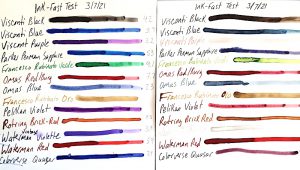
The ink proof sheet is on the left and the UV tested inks are on the right. Click the image above to get a better look at the ink tests.
This batch of inks was given a UV light fast test in our sunniest window from March 7, 2021, to June 7, 2021. We also tested the pH levels of the inks to see just how neutral they are. The following is all raw data that we thought you might find interesting. As we do not know the chemical composition of each ink or ink sac/converter it might go into, a pH neutral ink does not guarantee it won’t have a bad chemical reaction inside your pen. We have a professional pH tester, which we calibrated just before testing these inks. As a quick chemistry refresher, a pH of 7 is neutral like distilled water. The closer you get to 0, the more acidic the ink is. The closer you get to 14, the more alkali/base the ink is.
Surprises are the most enjoyable parts of these tests. Blues remain entirely unpredictable. One of my all-time favorite blues is Parker Penman Sapphire. Instead of fading out like most blues, it turned purple! Visconti blue fades out when thinly applied, but the thicker lines create a majestic blue-black that is even prettier than the original blue. Colorverse Quasar turned from a rich blue to a light red-purple. Omas blue did what most blues do and faded heavily. Acidity didn’t seem to effect which brands faded and didn’t. Omas was the most acidic blue at 2.3, and Colorverse was the most neutral at 7.9. Both underwent dramatic changes.
There were subtle changes in some of the inks. Visconti’s black turned a dark brown in the sunlight.
Purples fared poorly. Visconti Purple turned a pale pink. Vintage 1960s’ Waterman’s Violet almost completely disappeared. Pelikan Violet held on kinda, turning a deep reddish pink.
Waterman’s Red and Omas’ Red/Burgundy held up best. Neither seemed very effected by the sun. Also interesting was that Omas’ ink was also almost pH neutral at 7.2. We are often warned red can be the most dangerous color to put in a fountain pen. If it is pH neutral, I wonder what chemical reactions happen when it is inside a pen.
We had never previously heard of Francesco Rubinato inks before, but we loved the “Verde” green ink that was somewhere between “Shamrock Shake” and “Kelly Green.” Unfortunately, it turns into a bile-like yellow green with UV exposure.
An OLD bottle of Rotring Red was a very curious color. It was more of a brick red with a hint of orange. Was that because it was already discolored and UV exposed or was Rotring red really like that? Either way, UV didn’t effect the dry ink on the page.
The only color not yet mentioned is the Francesco Rubinato Oro (gold). This is a goupy, heavily sedimented ink filled with gold-glitter. We DO NOT recommend it for fountain pens. It is ONLY GOOD for DIP PENS. Anyhow, UV light didn’t effect it at all, and because we didn’t want to ruin our pH tester, we didn’t check its pH level, either.
Here is the table of our pH results:
Visconti Black…………………………..4.2
Visconti Blue……………………………3.9
Visconti Purple…………………………3.2
Parker Penman Sapphire…………..5.3
Francesco Rubinato Verde…………4.1
Omas Red/Burg………………………..7.2
Omas Blue……………………………….2.3
Rotring Brick Red…………………….8.5
Waterman (1960s) Violet………….3.9
Waterman Red………………………..5.9
Colorverse Quasar…………………….7.9
Pen World: Defining Vintage Part 1
Just what is it that makes a pen vintage? Many people are asking that question these days. As time advances, are the old definitions of “vintage” and “modern” really holding up? My article in Pen World Magazine is the first of a two part series. In Part 1, I put the question to 4 legendary experts who helped to build the pen collecting hobby into what it is today. In part 2, I will put the same questions to a new generation of collectors and users. Yet, for now, here is Part 1, reprinted here with permission from Nicky Pessaroff, editor of Pen World Magazine.
To better read each page, click the individual images.
Decameron 2020: The Headsman
EDITOR’S NOTE: I wrote this story in 1995, at the age of 19, for my creative writing class in college. At the time, the term ‘fan fiction’ hadn’t been coined. And, you couldn’t turn on the TV or go to the movies without a serial killer somewhere in the story. I’ve been downsizing my life a lot lately, as I settle into a new house with my fiancée. Yet, when I found this old story, it made me laugh, and I thought you might get a kick out of it, too. I’ve always been a little off kilter.

This moonrise over the Rhode Island shoreline has nothing to do with this story, but it is a pretty photo.
Ted’s muscular six-two frame hovered over an unconscious, naked brunette who was lying on a floor covered in newspapers. After taking a minute to appreciate the shine on his new hacksaw blade, he knelt down beside the woman’s neck.
Leveling the blade on the center of her throat, he began to cut, squirting blood into his graying hair. As he hit her spinal chord, his mother walked into the room—interrupting his insidious laughter.
“Theodore J. Greelak!” she yelled. “What in tarnation do you think you are doing?!”
Ted looked dumbfounded at her with his puppy-dog brown eyes.
“How many times do I have to tell you? No decapitating women in the living room! Hell! I bet you’ve only got one or two layers of newspapers to soak up the blood, too.”
“But, Ma, I thought it would be enough. Besides, I’m thirty-nine years old. Don’t you think I know what I’m doing by now?”
“Don’t, ‘But, Ma,’ me. Who’s going to clean up that wall with all that spattered blood?!”
“I’ll clean it up like always, Mothhhhher,” Ted hissed, trying to keep his temper.
The pudgy, short woman in her sixties just stood there in her fuzzy pink bathrobe, with her white-gray hair up in soup-can curlers, looking very indignantly at her son.
“Okay, okay,” Ted relented. “I’m sorry, Ma. I won’t behead anymore women in the living room. But won’t this one make a great addition to our collection of heads in the ‘fridge? You know, right next to the pickle jar.”
“Apology accepted,” she said, and then with tears of pride, “Oh, Teddy, you make your mother so proud. If only your father could be here to see this. Bless his soul. Yes, she’d be perfect next to the pickle jar.”
Ted smiled. He always wished his father, The Zodiac Killer, could have seen his great accomplishments before he died. He hoped his father was watching from wherever he was.
“This time, don’t hide the body so close to your work,” Ted’s mother advised. “The cops might be suspecting you. In fact, I think I heard on TV that they had a new suspect in ‘The Headsman’ case.”
“Okay, Ma. I’ll start watching my back a little more closely.”
•••

Sunset at Uncas Falls is pretty, but it also has nothing to do with this story. Just wanted to share some photographic art with you.
Ted lit up another Marlboro and took a swig from his beer. As he looked up at his friend Ron, he asked, “Do you ever have doubts about the integrity of what we’re doin’?”
“What do ya mean?” his younger friend inquired.
“Well, I mean, in all of your years of strangling, disemboweling and necrophilia, do you ever stop to wonder why? Why bother?”
“Naww, man. This is the ’80s, and we’re alpha predators at the top of the food chain. This is the life,” Ron declared. “You know what your problem is? You never have sex with the women you behead. That’s half the fun of it.”
“Yuck, man, they’re dead,” Ted stated in disgust before asking, “What’s it like, anyhow?”
“Haven’t had any complaints,” Ron dryly quipped.
They had a long, hard laugh, and Ted ordered another round.
Ted then turned somber. “Ya know, I’m thinkin’ of turning in the ol’ hacksaw and movin’ on.”
Ron looked at his friend with concern. “You’re serious, aren’t you? You really think you could give it up?”
“It’s just losing its spark. I mean, picking up a woman at a bar, clubbing her unconscious, ripping off her clothes and cutting off her head just doesn’t do it for me any more,” admitted the disgruntled serial killer.
“Yeah, but, you’ve held this town under a 20-year reign of terror. EVERYONE fears ‘THE HEADSMAN.’ No one can utter your name without somebody shuddering. You can give all that up, just like that?” Ron snapped his fingers to emphasize his point.
Downing half his beer, Ted tried explaining the situation further, “It’s like this, Ron. I’m about to turn forty, still live at home, have a go-nowhere job at the train station and have killed 125 women with no positive recognition. No dinner at the mayor’s. No parades in my honor. No accolades. The only respect I get is from the killer community. Hell. I’m not even the FBI’s most wanted.”
“I hear ya, but what about the integrity of your art form?” Ron lamented. “No one can saw off a human head the way you can.”
With a determined look on his slowly aging face, The Headsman knocked off the rest of his beer and made a decision. “That’s it. Tomorrow, I’m packing my trusty hacksaw in mothballs, quitting my job and moving tooooo…Baltimore.
“You are my best and only friend in this town, Ron, and I will miss you a lot, but this is something that I just have to explore.”
“Okay, but why on earth would you want to go to Baltimore?” Ron asked, with a befuddled look on this face.
“I’ve been pondering this one, myself,” Ted settled into a story. “I’m beginning to believe that fate sometimes just steps in and takes your hand. You see, this whole retirement from killing has been playing on my mind for quite some time, and then Mary-Kate, my last victim, helped me decide.”
“Why,” Ron asked. “Was it before she realized you’d kill her?”
“Oh no. She was already dead when she helped me,” Ted explained. “I was picking up her headless body, about to carry it into the bathroom to let her drain into the tub, when I noticed a peculiar ring of blood around a job listing for a sales job in Baltimore.
“Since I studied sales and marketing in college, I gave them a call. After a couple interviews over the phone, they gave me the job!”
“Congrats,” Ron offered. “But I wish you would stay. Death, murder and mayhem in this town won’t be the same anymore without you.”
“I’m sorry,” Ted said. “A serial killer has got to do what a serial killer has got to do. In my case, that is to grow up.”
ONE YEAR LATER AT A POWER LUNCH WITH HIS BOSS

The site of the former Mohegan Campgrounds on the Yantic River. This, too, has nothing to do with the story.
“You know, Ted, it looks as though you are going to be the salesman of the month for the third time in a row,” congratulated Ted’s boss, a polished young man in an expensive suit. “You’re a real cut above the rest, Mr. Greelak. You have a killer instinct that I have never encountered in our other salesmen. We are considering making you a junior partner, if you keep up this good work.”
“Thank you, Mr. Morrison,” Ted said, a little awestruck. “That would be very generous of you and the company. I would appreciate that very much.”
“Just keep it up, and you will have earned it,” Mr. Morrison explained. “May I ask you personal question?”
“Sure.”
“Why did such a cut-throat salesman, such as yourself, wait so long to get into this business?” Mr. Morrison asked, taking a sip of his scotch. “If you had started fifteen years ago, at your rate, you would be running the company by now.”
“You really think so?”
“Yes, I do.”
“Although I am ashamed to admit it,” Ted confessed, “I was sort of obsessed with women.”
His boss gave him a knowing smile and leaned back in his chair. With admiration in his voice he said, “Ahhh. A sales shark and a lady killer.”
“I guess you could say that,” Ted smiled before changing the conversation. “I’m also a little embarrassed to ask, but, does our insurance cover any psychological assistance?”
“Yes, why? Is everything all right?”
“Oh, its nothing really,” Ted half lied. “It is just that I’ve met this really special girl, and I am concerned about juggling the stress of an important career and a relationship.”
“No problem,” Mr. Morrison said with a devilish grin. “I will see to it personally that you get the best psychiatrist in town. Can’t let my best salesman get avalanched with stress. I’ll have the number on your desk by morning.”
“Thank you, sir.”
ONE WEEK LATER
“Ya know, Doc,” Ted explained while lying on a psychiatrist’s couch. “For a while there, I thought I had it licked.”
“Please tell me more about it,” instructed the doctor in his late 50s.
“Let’s see. I guess I didn’t start killing for about seven months. I was and still am rising through the corporate ranks, in spite of my late start and cross-country move. Then one day it just happened.”
“Go on,” encouraged the doctor. “What, ‘just happened’?”
“I met this fox of a woman named Joanne in a bar,” Ted relived the moment of attraction. “She had thick red hair in one of those chic short haircuts and brilliant blue eyes. Her lips were bright red contrasting perfectly against her pale white skin. I would have killed for her.”
“And you did.”
“Yes,” Ted enthused. “I started telling her I was a serial killer and about my deranged obsessions like it was a strange pick-up line. She fell for it. Pretty soon I got her back to my place and began a new head collection in my fridge. She’s still there in my most honored greens and vegetables drawer.”
“But don’t you think you are regressing back to the way your life was when you were originally killing?” the doctor asked.
“No, no. It’s different now,” Ted elaborated. “Then I felt as though I had to continue my father’s legacy. Now I’m at one with myself. I’m living on my own and am becoming an important business man. I’ve established my own person. My murdering is now for my own personal pleasure.”
“You’re a very fascinating man, Theodore,” the psychiatrist acknowledged. “I would be interested in getting to know you more personally. Why don’t join me this Friday night for dinner? We would be having liver with some fava beans and a nice chianti.”
“Yummm. Dr. Lecter, that sounds delicious. I’d love to join you.”
The End?
Whoa! Montblanc Inks…Beware!
Happy New Year, everybody!
Sorry for the long absence. December and early 2022 have been quite the rollercoaster. Happily, all is well now, and we hope to be back to rockin’ and rollin’ the ink-o-sphere.
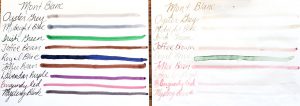
Wow! Three months in the sun fades the pigment right out of modern Montblanc inks. Mont Blanc ink burns worse than I do in sunlight.
The biggest shock to me in Dawn’s and my ink tests comes from Montblanc! At $26 retail for a 60ml bottle of ink, you’d think you’d get something close to perfection…especially with the company’s luxury marketing! It is worth it to do a little math here. A 60ml bottle of ink at $26 per bottle means the price of a single milliliter of ink is 43¢. A U.S. gallon is a shade over 3,785 milliliters. Ergo, a gallon of Montblanc ink costs $1,627.55! A gallon of gasoline here in Norwich is $3.39, and a gallon of milk can be found for $4.29. It will seem as though gas and milk are a better bargain, especially after these results.
Now before you start thinking I’m being completely unfair to Montblanc, I’ve always liked its ink. At pen shows I use it as my test ink for anyone wanting to dip a nib to try out a pen. When people asked me what was one of the safest brands of ink…based on no research but word of mouth around pen shows…I’d usually tell them they could trust Montblanc best.
I hereby rescind that proclamation of safety. I got my first wind that trouble was in the air when a customer returned a pen to me after only 3 or 4 months of use with Montblanc Mystery Black ink. Its rubber ink sac had melted. At the time, I thought that was weird and worried the customer had used something far more toxic and then tried to cover it up with Montblanc Mystery Black. Nope. I doubt that now.
Back in July, 2021, I stuck a sample of 8 new bottles of modern Montblanc ink swatches in my sunniest window. These inks included: Oyster Grey, Midnight Blue, Irish Green, Toffee Brown, Royal Blue, Lavender Purple, Burgundy Red and Mystery Black.
After only 3 months in the sun, nearly all faded out! Royal blue turned a faded green. Irish Green and Lavender Purple almost went invisible.
When Dawn and I tested the fresh ink’s pH, we were equally surprised. For a quick chemistry refresher. Everything is measured in pH on a scale from 0 (extremely acidic) to 14 (a base that is extremely alkali). 7 (distilled water) is perfectly neutral. We calibrated our pH tester at 24.6ºC.
Here are our results from the Montblanc ink pH Test:
Mystery Black 4.3
Royal Blue 3.8
Burgundy Red 4.8
Midnight Blue 4.2
Irish Green 3.9
Oyster Grey 3.9
Toffee Brown 5.6
Lavender Purple 3.8
All of these inks are quite acidic. Blue and black inks are supposed to be the safest inks. They are very acidic in Montblanc! Now, we aren’t chemists. We do not know how the chemistry between the ink sacs, pistons and converters interacts with the ink. Yet, this raw data casts doubt on the safety of Montblanc ink. Perhaps it is the special “cleaner” Montblanc uses to keep inkfeeds clear that is to blame for the acidity. The company recommends only using MB ink in MB pens. Perhaps there is more to that than just their greed of simply wanting to sell more ink.
As we still have a few of the old bottles of Montblanc ink from the 1990s, we didn’t do a UV test on them, but we did a pH test and it was even worse.
Black 2.2
Turquoise 2.8
Red 6.5
Green 3.0
Maybe you’ve had great results. I certainly don’t want to ruin your faith in Montblanc ink, if it has always worked for you. However, it might not be the gold standard I once thought it was. The information here is simply raw data, but it seems striking.
Holiday Slowdown
Due to forces outside our control, we will not be able to ship any packages from orders made between December 2 and December 12. There is a family emergency that is forcing this situation. The good news is that everyone will be okay, but we aren’t going to be able ship during this period.
You can continue ordering pens, and we will ship them just as soon as we are able.
I am terribly sorry for this inconvenience. We still wish you the happiest of holidays, and hope to fulfill your inky desires as soon as we can.
Levenger’s Ink Kicks Ass!
Mathematical and computer genius Alan Turing famously said, “Sometimes it is the people who no one imagines anything of who do the things no one can imagine.” In addition to being one of my all-time favorite quotes about people, it seems to apply to the world of fountain pen inks, too.
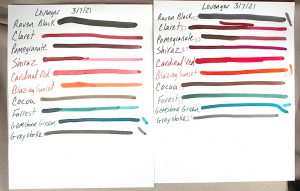
Here is a side-by-side comparison of Levenger’s ink left in the sun for 3 months and the proof sample saved in the dark.
Ink collectors today understandably go ga-ga for Iroshizuku, Diamine, ColorVerse, J. Herbin, Noodlers and many other brands. Yet, often overlooked, is Levenger’s Ink. In many respects, Levenger’s kicked off the ink-color craze a decade or two before our current manufacturers and spectrum were readily available. Levenger’s has had scores of inks of every hue available since some time in the 1990s. Better yet, they are far more affordable than the competition.
Nevertheless, I kinda blew them off…until I stumbled into a large collection for sale. When Dawn and I started testing them for UV light fastness and pH balance, we were blown away.
We started testing 17 colors in March. From March 7, 2021, through June 7, 2021, we hung these samples in the sunniest window of our house. Afterward, we tested the ink still in the bottles with a pH meter calibrated to 21ºC.
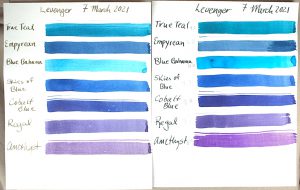
Here is a side-by-side image of Levenger’s inks left in the sun for 3 months and the sample proof left in the dark.
Without a doubt, these are the most consistently light-fast inks we have tested to date. Even the worst-hit inks were still very close to their original colors. Blue Bahama likely lost the most vibrancy, but it is still easily read and distinguished. Cardinal Red faded to a rich pink, but it is still quite legible. Raven Black, Gemstone Green and Greystoke got DARKER in the sun!
Given the great results from the light-fast testing, we feared the worst with the pH tests. BUT! We were only further dazzled. Many of the inks were very close to neutral, and none of the inks veered off the spectrum of acidic or alkali.
As a basic chemistry refresher, 7 in a pH test is neutral. Distilled water is 7. The closer to 0 you go, the more acidic something is. In the opposite direction going up to 14 is more base or alkali. In theory, you don’t want an acid or a base sitting in your ink sac for too long. Yet, one thing we always like to remind people is that regardless of what the pH result is, we do not know the chemistry of the ink nor how it interacts with your rubber ink sacs, celluloids or converters and the like. Depending on the chemical reaction between the ink and what it is resting in, a neutral ink can do damage and an acidic ink might be safe. The pH measurement is simply a data point we find fascinating, but it doesn’t necessarily indicate which inks are safest for your pens. With that in mind, here are our Levenger pH results:
Ink Color pH Measurement
True Teal 7.1
Empyrean 6.8
Blue Bahama 6.6
Skies of Blue 7.3
Cobalt Blue 8.0
Regal 7.2
Amethyst 8.4
Raven Black 8.3
Claret 8.7
Pomegranate 8.3
Shiraz 8.7
Cardinal Red 6.8
Blazing Sunset 6.7
Cocoa 7.3
Forest 7.1
Gemstone Green 7.2
Greystoke 7.4
As always, I hope you find this information to be interesting and enjoyable.
Another Fine Story in ‘Pen World’
October has another sizzling story by your’s truly in Pen World. In it, I delve into the undersung history of the humble inkfeed. Click on the images to see larger versions and enjoy a free sneak peek courtesy of editor in chief Nicky Pessaroff and Pen World Magazine. To read the whole incredible issue, be sure to pick up a subscription!
Decameron 2020: Mr. Hobbs Revisited (Finalé)

Preston, Connecticut, is home to several abandoned asylums for the mentally deranged. They make Arkham look like a pleasure zone. This story has nothing to do with asylums but it is an awesome photo for Halloween.
Editor’s Note: Unfortunately, this shall be Art Cerf’s last “Decameron 2020” story. Perhaps he will come up with some more great stories for us in the future. For now, he’s hoping to take a break. Better known to me as Dad, it is wonderful to write with and entertain with him on this blog. Thanks, Dad, for all of the wonderful fun.
Mr. Hobbs Revisited (Finalé)
By Art Cerf
We end this series of stories by flashing back to the very first, the tale of Mr. Hobbs. In that one, he was a ghost in real life and a ghost when life was over. It seems Mr. Hobbs needs a bit of an update.
He lost his father when he was four and so became very close to his mother. Throughout his life, he had no love affairs, not even a girlfriend. But don’t blame Mom. She was always encouraging him to meet new people, find friends, date a girl. But Hobbs was an introvert and very shy and he felt he needed no one but his mother.
Looking back upon his life, he remembered one young woman in particular. Her name was Sarah Montgomery and she was a teller at his bank when he was a young man. She wasn’t fat or thin, tall or short, not a beauty but not ugly either…just an ordinary-looking lady. Except for her eyes…how they sparkled with interest about everything around her, including Hobbs.
Sometimes, they’d lunch out back together and she would prattle on about anything and everything and he would answer “Yes” or “No” or offered a three-to-four word reply.
How she loved swing music…Artie Shaw, Benny Goodman, Glenn Miller and the like, even if their moment had been 30 years earlier.
Anyway, she would have been more than willing to go out with Hobbs but he never could muster the courage to ask her. And within a year, she moved onto another job.
Decades passed, and then one day he ran into her at the grocery. Her hair now was grey but her eyes still sparkled with enthusiasm. She recognized him immediately and they spoke for several moments as the cashier’s line dwindled. No, she never married and the young man with her was her sister’s grandson.
Finally, they exchanged numbers and Hobbs never felt better…and never would.
That night he suffered a stroke and would be dead within a month. Sarah saw his obit in the paper and shed a genuine tear.


 Shopping Cart
Shopping Cart



